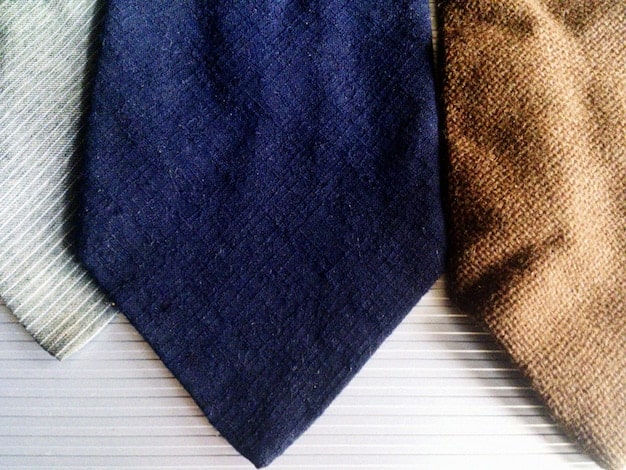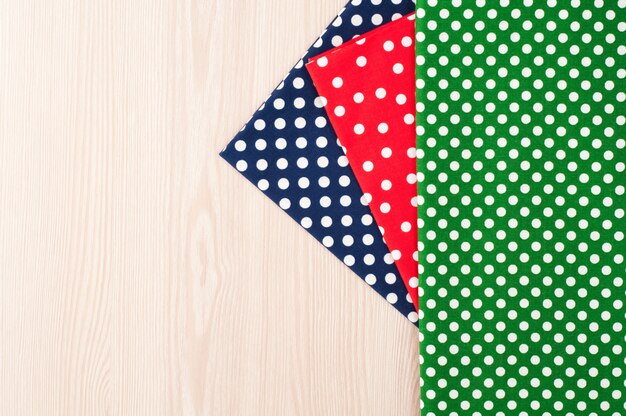How to Choose the Right Tie for Your Suit: A Comprehensive Guide

Choosing the right tie for your suit involves considering factors such as tie width, fabric, color, pattern, and knot style to complement your suit’s lapel width, shirt color, and overall personal style, ensuring a polished and cohesive look.
Looking to elevate your style and make a lasting impression? Knowing how to choose the right tie for your suit is essential. A tie can either make or break your outfit, so let’s explore the key elements to ensure you always look sharp and sophisticated.
Understanding Tie Width and Suit Lapels
The width of your tie should be proportional to the width of your suit’s lapels. This creates a balanced and harmonious look. Let’s delve into how to match these elements for optimal style.
Matching Tie Width to Lapel Width
A general rule is that your tie should be roughly the same width as your lapel at its widest point. This principle ensures that neither the tie nor the lapel overpowers the other.
For instance, if you are wearing a suit with slim lapels, opt for a narrower tie. Conversely, if your suit has wider lapels, a wider tie will maintain a balanced appearance.
- Slim Lapels: Pair with ties that are 2 to 2.5 inches wide.
- Medium Lapels: Choose ties that are 2.5 to 3 inches wide.
- Wide Lapels: Select ties that are 3 to 3.5 inches wide.
Ignoring this guideline can result in an unbalanced look. A wide tie with slim lapels might look outdated, while a skinny tie with wide lapels can appear disproportionate and awkward.
Ultimately, the goal is to create a cohesive and polished appearance where all elements of your outfit work together seamlessly.
Selecting the Right Tie Fabric for Your Suit
The fabric of your tie plays a significant role in its overall appearance and how well it complements your suit. Factors like the season, occasion, and suit fabric should influence your choice.
Silk Ties: A Classic Choice
Silk ties are a versatile and timeless option suitable for nearly any occasion. Their smooth texture and subtle sheen add a touch of elegance to any suit.
Silk ties come in various weights and textures, allowing you to find the perfect match for your suit. Lighter silk ties are ideal for warmer weather, while heavier silks work well in cooler months.

Wool Ties: Ideal for Fall and Winter
Wool ties offer a more textured and substantial look, making them perfect for fall and winter. They pair exceptionally well with tweed or flannel suits.
The matte finish of wool ties provides a nice contrast to smoother suit fabrics. They also add a layer of warmth, both literally and visually, to your outfit.
- Tweed Suits: Complement with textured wool or knit ties for a rugged, sophisticated look.
- Flannel Suits: Opt for wool or cashmere ties for a soft, luxurious feel.
- Avoid: Wearing a wool tie with a lightweight summer suit, as it can look out of place.
Choosing the right fabric is crucial for ensuring your tie complements your suit and the overall aesthetic you’re aiming to achieve.
Choosing the Right Tie Color for Your Suit
Color is one of the most impactful elements of a tie. It can set the tone for your entire outfit and should be chosen carefully to complement your suit and shirt.
Classic and Versatile Colors
Navy, burgundy, and gray are excellent choices for ties, as they are versatile and pair well with a wide range of suit and shirt colors. These colors are suitable for both professional and social settings.
Navy ties are particularly adaptable, complementing almost any suit color, including gray, navy, and even lighter shades like beige or tan. Burgundy ties add a touch of sophistication and pair well with navy, gray, or charcoal suits.
Bold and Statement Colors
For those looking to make a statement, bolder colors like red, green, or purple can be effective. However, it’s essential to use these colors judiciously to avoid overpowering your outfit.
- Red Ties: Best paired with neutral suits like gray or navy, providing a pop of color without being overwhelming.
- Green Ties: Work well with earth-toned suits, such as brown or olive, creating a harmonious and stylish look.
- Purple Ties: Add a touch of regalness and can be paired with gray or navy suits for a distinctive appearance.
When choosing a tie color, always consider the overall context. A bright red tie might be suitable for a festive event but may not be appropriate for a conservative business meeting.
The key is to find a balance that reflects your personal style while remaining appropriate for the situation.
Patterns: Adding Personality to Your Tie
The pattern of your tie is another crucial element that can enhance your outfit. Patterns add depth and personality to your attire, but it’s important to choose them wisely.
Classic Patterns
Classic patterns like stripes, polka dots, and paisley are timeless and versatile options. These patterns can add visual interest to your outfit without being too overwhelming.
Striped ties, also known as repp ties, are a staple in many wardrobes and pair well with solid shirts and suits. Polka dot ties offer a playful yet sophisticated look and work well with solid or subtly patterned shirts.
Modern and Bold Patterns
For a more contemporary look, consider ties with geometric patterns, floral designs, or abstract motifs. These patterns can add a fresh and stylish touch to your outfit.

- Geometric Patterns: Best paired with solid suits and shirts, creating a modern and visually appealing contrast.
- Floral Designs: Suitable for more casual or creative settings, adding a touch of personality and charm to your attire.
- Abstract Motifs: Offer a unique and artistic flair, ideal for those looking to stand out with their style.
When choosing a patterned tie, consider the scale of the pattern. Smaller patterns are generally more versatile and easier to pair with other garments, while larger patterns can be more challenging to coordinate.
Ultimately, the pattern you choose should reflect your personal style and complement the rest of your outfit.
Choosing the Right Knot for Your Tie
The knot you choose for your tie can impact its overall appearance. Different knots work better with different tie fabrics, collar types, and occasions.
The Four-in-Hand Knot
The Four-in-Hand knot is a classic and versatile choice that works well with most tie fabrics and collar types. It is easy to tie and creates a slightly asymmetrical knot.
This knot is particularly suitable for ties made of thicker fabrics, as it doesn’t create an overly bulky knot. It also works well with button-down collars and other casual collar styles.
The Half Windsor Knot
The Half Windsor knot is a more symmetrical and balanced knot than the Four-in-Hand. It’s a good option for those seeking a more formal and polished look.
- Best for: Ties of medium thickness and spread collar shirts.
- Creates: A neat, triangular knot that fills the collar space appropriately.
The Full Windsor Knot
The Full Windsor knot is the most symmetrical and formal of the three. It creates a large, triangular knot that is best suited for wide spread collar shirts and ties made of thinner fabrics.
This knot is often used for important business meetings and formal events. However, it can be too bulky for some tie fabrics and collar styles.
Experimenting with different knots can help you find the perfect one for your tie and outfit. Consider the fabric of your tie, the style of your collar, and the occasion when choosing a knot.
Ultimately, the right knot should enhance the appearance of your tie and complement your overall look.
Consider the Occasion and Setting
The occasion and setting should also influence your tie choice. Different events call for different levels of formality and style.
Formal Events
For black-tie events, a black bow tie is the traditional choice. However, for less formal events, a dark-colored silk tie with a subtle pattern can be appropriate.
Consider using a Full Windsor knot for these events, as it conveys sophistication. This will convey a smartness and professionalism to your fit.
Business Settings
In professional environments, conservative ties in navy, burgundy, or gray are good choices. Avoid ties with overly bold patterns or colors that might be distracting.
- For Interviews: Opt for a solid or subtly patterned tie to convey professionalism and attention to detail.
- For Client Meetings: Choose a tie that reflects your company’s branding and values while remaining appropriate for the setting.
Casual Outings
For casual events, you have more freedom to experiment with colors, patterns, and fabrics. Knit ties, linen ties, and ties with bold patterns can add a touch of personality to your outfit.
Consider the climate when making your choice, for example, it is better to go with a lighter material during summer.
Remember, the goal is to choose a tie that is appropriate for the occasion and reflects your personal style while respecting the setting.
By considering the occasion and setting, you can ensure that your tie always makes the right impression.
| Key Element | Brief Description |
|---|---|
| 📏 Tie Width | Match tie width to suit lapel width for a balanced look. |
| 👔 Fabric Choice | Select fabric (silk, wool, etc.) based on season and suit. |
| 🎨 Color Coordination | Choose colors that complement shirt and suit; consider the occasion. |
| 🪢 Knot Style | Select a knot (Four-in-Hand, Windsor) that suits the tie’s fabric and collar style. |
Frequently Asked Questions
▼
The ideal tie width generally matches the width of your suit lapels, typically ranging from 2 to 3.5 inches. This ensures a balanced proportion and a polished look.
▼
For summer, lightweight fabrics such as linen or cotton are excellent choices. These materials are breathable and help you stay comfortable in warmer weather, while maintaining style.
▼
Select patterns that complement your shirt and suit without being too overwhelming. Classic patterns like stripes or polka dots are versatile, while bold patterns can add personality to an outfit.
▼
For a job interview, a conservative and professional knot like the Four-in-Hand or Half Windsor is recommended. These knots convey competence and attention to detail.
▼
Yes, but ensure the patterns vary in size and scale to avoid clashing. For example, pair a narrowly striped shirt with a tie featuring larger polka dots for an appealing contrast.
Conclusion
Choosing the right tie involves paying attention to width, fabric, color, pattern, and knot, and also the event you are thinking of attending. By considering these factors you can combine them to complete the perfect outfit and show true style.





